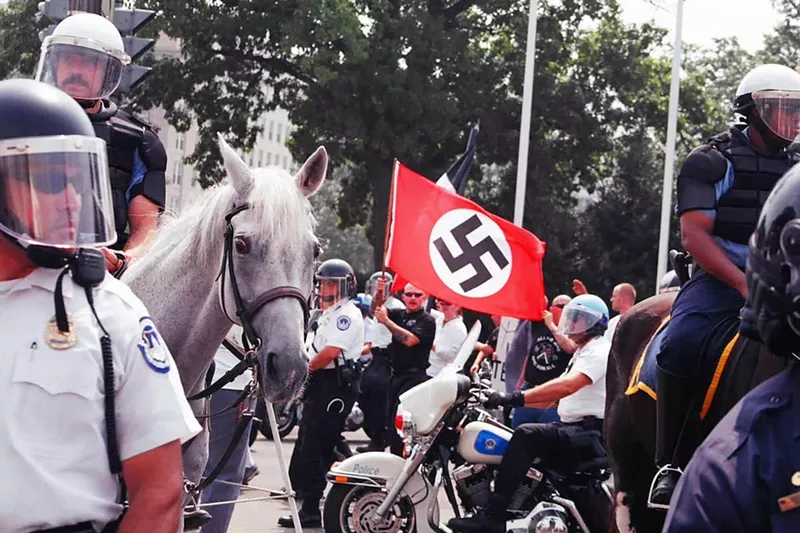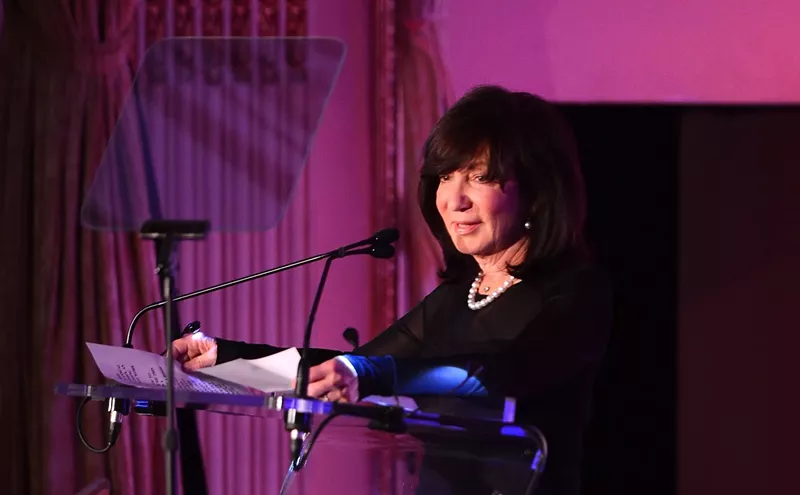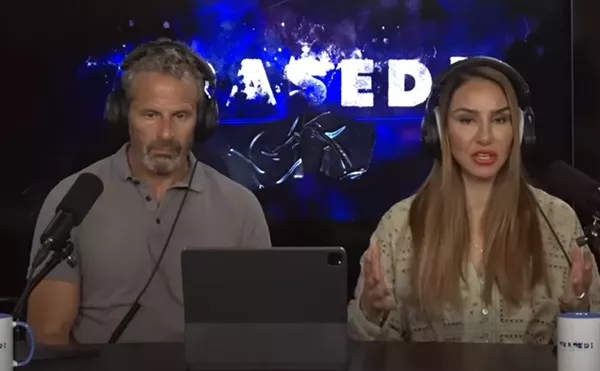Deep in the woods, a mosh pit of shirtless, headbanging skinheads pumps fists to the shrieking ballad of a punk-rock guitarist. Loudest among them is Frank Meeink, a buzzcut-wearing 17-year-old with a tattoo of Nazi propagandist Joseph Goebbels on his chest and a swastika inked on his neck. Extending his right arm, the teenaged neo-Nazi screams, “White Power! White Power!”
At the time, Meeink was one of the angry young men featured in Skinheads USA, a 1993 documentary in which members of the Aryan Youth Front announced their campaign to claim Alabama as a “white homeland.” However, Meeink has since defected from the racist organization after a prison sentence transformed his white-supremacist beliefs.
Meeink has been a civil rights activist for nearly 30 years. Now in the wake of the white-supremacist terror attack in Charlottesville, the former media darling of neo-Nazi gang recruitment plans to lecture against white nationalism and violence at Eckerd College in St. Petersburg this September 7.
"A lot of these people aren't even from down South, so they don't care about the South," Meeink says of the white nationalists in Charlottesville. "It's not their heritage, you know?... They just want to use these statues to get an argument going."
Born in South Philadelphia, Meeink grew up the son of an absent biological father; an alcoholic, drug-addicted mother; and an abusive stepfather, who nicknamed him "prisoner of war." Battered at home and bullied at school, a 13-year-old Meeink escaped one summer to his relatives' farm in Lancaster, Pennsylvania. While he was there, his older cousin, a skinhead with Confederate flags and Adolf Hitler wallpaper in his bedroom, introduced him to a small group of neo-Nazi recruiters, who quickly welcomed him. One year later, Meeink shaved his head and declared his commitment to the movement. By the time he was 17, he had his own cable-access show in Illinois called The Reich and was one of the best-known skinhead gang leaders in the nation.
Later that year, police officers found a videotape of him kidnapping and beating a member of a rival skinhead gang. Charged as an adult, Meeink was sent to a prison near Springfield, Illinois, where he lived in close quarters with young men of other races. Realizing the white inmates were neither friendly nor interested in sports, Meeink joined the football league of his African-American and Latino cellmates. Soon enough, they were friends.
Once he was released from prison, Meeink found himself struggling to revert to his prior prejudices after having bonded with people of other races. He had even become friends with a Jewish antiques dealer who had hired Meeink in spite of his criminal record. Embarrassed by his beliefs, Meeink shed the toxic ideology and ultimately left the white-supremacist movement.
Embed from Getty Images Shortly after he defected, Meeink helplessly watched the news as 168 people died in the 1995 domestic terrorist truck bombing that racked Oklahoma City. After seeing a photo of a firefighter cradling the lifeless body of a little girl, Meeink became tormented by guilt and immediately called the Anti-Defamation League to offer any services he could. For the next two decades, the reformed skinhead became an activist, giving lectures on racial diversity and acceptance across the nation. He has since written an autobiography that he discusses on his tours.
This past summer, the Florida Holocaust Museum invited Meeink to speak in St. Petersburg. Though the talk was planned months ago, Elizabeth Gelman, the museum's executive director, calls the timing "prescient," considering the recent tragedy in Virginia, where counterprotester Heather Heyer was murdered and 38 others injured by a neo-Nazi.
Meeink says white supremacists are well aware that reclamation of the entire country would be futile. He anticipates they will simply "try to build a white homeland for themselves in America — 'a piece for themselves.'" He also believes they're aware that operating under the legacy of Nazism won't help their cause.
"They've always been on the wrong side of history, so the difference now is they're going to be rebranding themselves," he says.
That's why Meeink says it's important to label hate groups as such. "Nowadays, your kid tells you he's joining an organization with a nice name like 'Family Leader,' which sounds great until you find out it's an anti-gay or anti-immigrant hate group."
Although Meeink encourages active condemnation of hate groups as a whole, particularly their recruitment of young people, he believes communication among individuals is key to battling the fear-mongering tactics of white supremacy.
"It isn't true that human beings don't change. Saying 'once a racist, always a racist' isn't helpful, because every racist person has an exception, like they'll say, 'We hate black people, but, oh, you know what? Tony is cool,'" Meeink says.
Even so, Meeink recalls lectures in which audience members weren't as receptive to open dialogue. He says a white supremacist once approached him at one book-signing event and whispered that he hoped all of Meeink's readers would be raped. At another event, in Indiana, a convicted skinhead heckled Meeink during the Q&A session, wielded a "swastika book," and called African-Americans apes.
"When it was over, the students from the black student union at the university said they were worried about my well-being and walked me back to my hotel," he says.
Gelman says she hopes Meeink's journey from racism to tolerance to civil rights activism can inspire today's angry young men prone to recruitment by white-supremacist groups.
"It's important for people to hear from someone who knows what it's like to be on the inside of this movement and can explain why this movement is attractive," she says. "That [Meeink] can give us a window into that world shows there's still hope — that people can change their beliefs away from the terrible mindset of hatred."

Audio By Carbonatix
[
{
"name": "GPT - Billboard - Slot Inline - Content - Labeled - No Desktop",
"component": "22004575",
"insertPoint": "2",
"requiredCountToDisplay": "2"
},{
"name": "STN Player - Float - Mobile Only ",
"component": "22595215",
"insertPoint": "2",
"requiredCountToDisplay": "2"
},{
"name": "Editor Picks",
"component": "17482312",
"insertPoint": "4",
"requiredCountToDisplay": "1"
},{
"name": "Inline Links",
"component": "18711090",
"insertPoint": "8th",
"startingPoint": 8,
"requiredCountToDisplay": "7",
"maxInsertions": 25
},{
"name": "GPT - 2x Rectangles Desktop, Tower on Mobile - Labeled",
"component": "23181625",
"insertPoint": "8th",
"startingPoint": 8,
"requiredCountToDisplay": "7",
"maxInsertions": 25
},{
"name": "Inline Links",
"component": "18711090",
"insertPoint": "8th",
"startingPoint": 12,
"requiredCountToDisplay": "11",
"maxInsertions": 25
},{
"name": "GPT - Leaderboard to Tower - Slot Auto-select - Labeled",
"component": "17720761",
"insertPoint": "8th",
"startingPoint": 12,
"requiredCountToDisplay": "11",
"maxInsertions": 25
}
]












